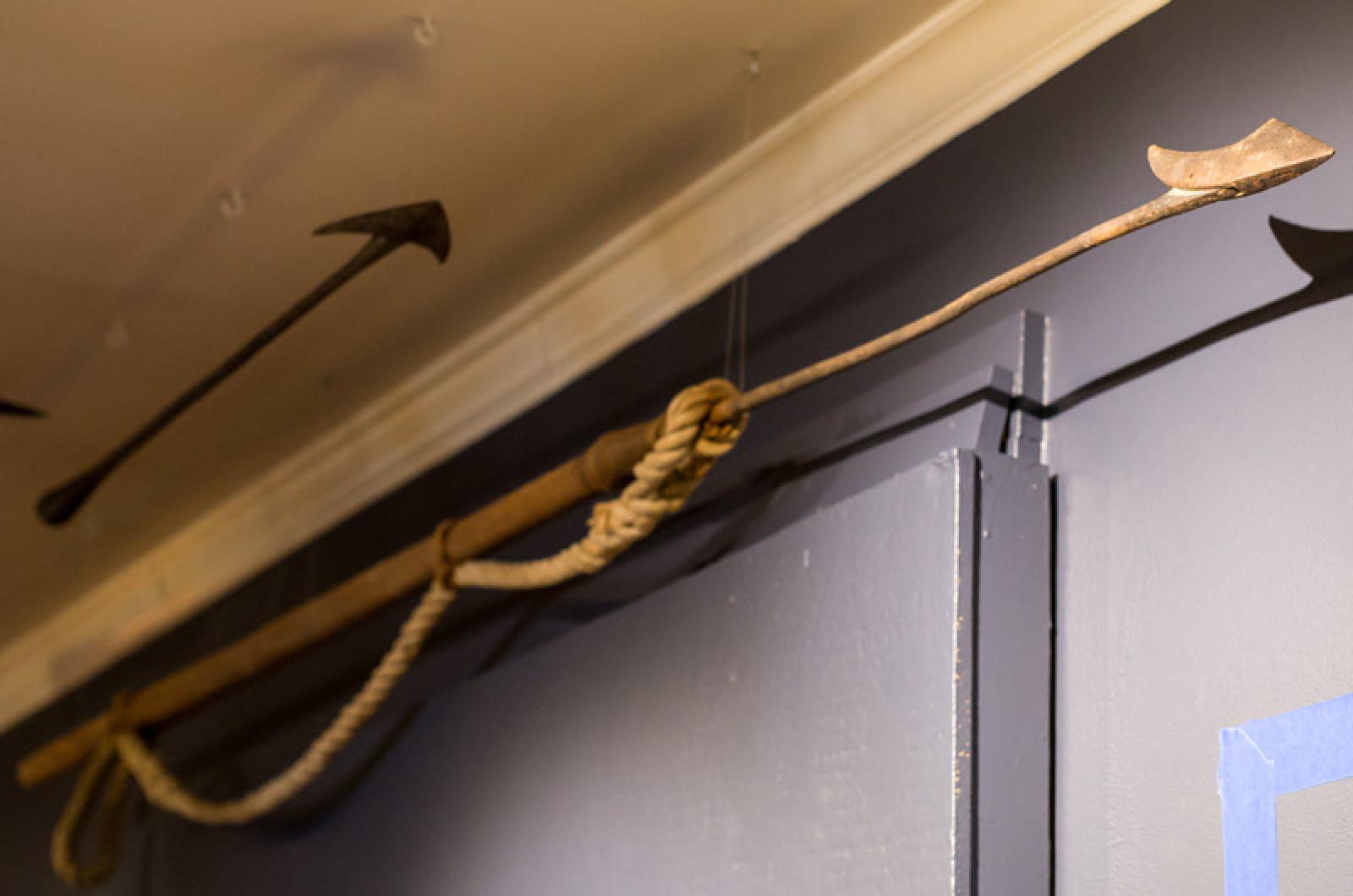From the February 2, 1962 edition of the Vineyard Gazette:
Cap’n Stuart Bangs, who never fails to call the attention of the Gazette to the new, the novel, the ancient or the startling, exhibited a whale-iron or harpoon, this week, which contains all of the characteristics mentioned.
In length, the iron is about the same as the harpoon head and shank of tradition, about thirty inches. But the shank is not round but flat, slightly more than an inch in width, with a rib, so-called, cast into each edge, for stiffening. It does not end in a socket, but has a flat disc, about the size of a twenty-five-cent piece, secured to the end of the shank by means of a burred end protruding through a hole in the disc.
The point is of the ancient arrow-shaped design, with broad, curving barbs, and very sharp on the edges. But at the extreme point it is slitted at right angles to the barbs, and into this slit is fastened, by a weld, a flat, leaf-shaped blade, thin, flat and sharp, and projecting beyond the harpoon head something over two inches. This extra point or blade, is about an inch in width at the broadest part.
There are two half-inch holes drilled through the flat shank, a few inches from the head and slightly over an inch apart, and a third hole is nearer what may be termed the butt-end of the shank.
The iron has evidently been exposed to the weather for a long period of time but is in an excellent state of preservation. Memory recalls a design of iron, made to be shot from a harpoon-gun, which had a rod secured to the side of the shank, and parallel to it on which a ring was fitted to slide. From this depended a short length of chain, to which in turn, the tub-line was secured. The object of the chain was to prevent the blast from the discharge of the gun from burning off the line. The disc at the end of the shank suggests too, that this iron was supposed to be shot from a gun, but it is a rare type.

Through the years of whaling and since, the Gazette has received correspondence from many far and strange places of the globe, but it remained for the past week to bring a letter direct from the farthermost place of all - the South Pole. The air mail envelope was postmarked “Pole Station, Antarctica” and the cancellation stamp included the word “U.S. Navy Operation Deep Freeze.”
The Gazette’s South Pole correspondent was Admiral Allen M. Shinn, who sent greetings as “one of your most distant subscribers. However, I’m not changing my address permanently...
“It’s a midsummer day here at the Pole, one of the warmest in the year — high 18 degrees below zero, low 21 degrees below. And John MacKenty thinks he has weather problems at Outer Mongolia!”

While making repairs to the former house of the late Frederick G. Vincent of West Tisbury, Daniel Manter, contractor of that town, recently discovered copies of the Republican Standard of New Bedford beneath the shingles. Bearing the date of March 30, 1905, one edition carries much news from the Island, thus reflecting the lifelong interest, even passion, of its editor, George A. Hough, for the Vineyard. These items and other from various places convey the picture of that day which is interesting to those who enjoy making comparisons.
The U.S. Navy had been sending men-of-war to practice with heavy guns off the South Side of the Island during the preceding summers. Protests that the concussion was killing fish and thus injuring the industry had been received by V.H. Metcalf, Secretary of Commerce and Industry. These protests had come from Gloucester and other mainland points, but strangely, as the secretary pointed out in his findings, no one from the Vineyard had complained. These fishermen, operating nearest to the target area, reported, in some cases, that their seasonal catch had increased since the coming of the ships.
The secretary’s findings, and summarizing of the protests, were given four columns on the front page, and the headline indicated strongly that the protests appeared to be without foundation and that, in consequence, the ships would continue to come to the Vineyard.
Figures on the Island catch, chiefly by traps in the Sound, together with other figures from elsewhere, are of interest to present day fishermen. Also, as it is stated, the bluefish have nearly disappeared, having become more scarce through the years, and the mackerel catch has fluctuated greatly season by season.
This same edition carries the account, in four inches of space, of the annual town meeting of Tisbury. The town voted to purchase the water company, and also elected the following town officers: selectman, William J. Look; treasurer, John O. Norton; school board member, William G. Manter; tax collector, Holmes A. Swift; auditor, Leavitt Norton; constables, Henry M. Gould and Alvin H. Cleveland; cemetery commissioner, Benjamin C. Cromwell. Amounts appropriated included salaries, $1,060; schools, $3,500; hydrant rental, $1,040; streets, $2,650.
Compiled by Hilary Wall
library@mvgazette.com




Comments
Comment policy »